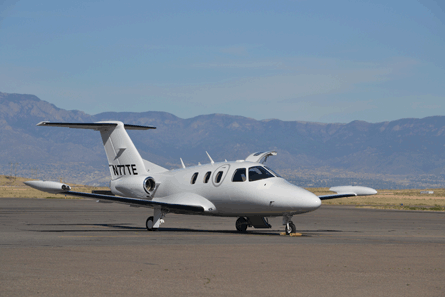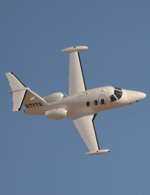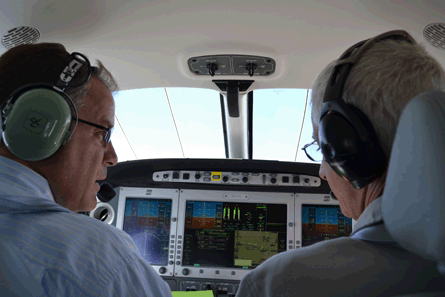 |
|---|
© John Croft/FlightglobalWith the Total Eclipse package, the Eclipse 500 is finally what was promised at launch |
With a new fully integrated avionics suite and the name Sikorsky on its masthead (as a minority owner), Eclipse Aerospace's Eclipse 500 very light jet is deserving of one last, long look.
On 28 April, I travelled to New Mexico to sample one of the latest aircraft to leave the former factory in Albuquerque - a converted DayJet air taxi - to evaluate the type in its most recent, and perhaps, final form.
That the Eclipse 500 remains available today despite its growing pains is testament to the value-and-fun proposition. Minority buy-in by Sikorsky in 2010 - to aid with both parts distribution and the eventual restart of the production line when and if economic conditions allow - only boosts the company's chances of being bigger and stronger for the type's tenth anniversary in 2016.
Conceived in the late 1990s and certificated in 2006, the Eclipse 500 promised to turn the status quo on its head. For less than $1 million, about the price of a Beechcraft Baron, the masses could buy a six-place twinjet that could fly four occupants more than 1,850km (1,000nm) in pressurised comfort. The original company (Eclipse Aviation) touted the type as "flying in the face of convention", but the development process was far from a breeze. Switching engine supplier from Williams International to Pratt & Whitney caused a two-year delay. The original Avidyne-sourced glass cockpit was binned in favour of an internally sourced "Avio" one.
PERFORMANCE PACKAGE
The first 38 aircraft delivered were unable to meet promised speed and range specifications, but an extended tip tank (ETT) performance package allowed subsequent aircraft to meet or exceed guarantees. A total of 260 Eclipse 500s were delivered to customers before Eclipse Aviation was liquidated in 2009.
Eclipse Aerospace took ownership of the defunct company's assets, opening shop in Albuquerque in September 2009. Since then it has taken steps to breathe new life into the Eclipse 500. Flight into known icing (FIKI) authorisation was obtained after most aircraft had been delivered to customers. Eclipse Aerospace is providing FIKI as well as avionics upgrades at its facilities in New Mexico and Illinois.
Additionally, it has upgraded about half of the pre-ETT production aircraft to the ETT configuration. All upgrades were done at customer expense, as Eclipse Aerospace has no obligation to bring aircraft into the configuration promised by the defunct Eclipse Aviation.
 |  |  |
|---|
© John Croft/FlightglobalThat the Eclipse 500 remains available today despite its growing pains is testament to the value-and-fun proposition |
|---|
In addition to upgrading customer aircraft, Eclipse Aerospace has been busy marketing 28 former DayJet aircraft. DayJet, a Florida-based air taxi operator, was at one time Eclipse's biggest customer with 239 firm orders. After DayJet's liquidation, Eclipse Aviation took possession of 28 DayJet aircraft. Eclipse Aerospace took control of these aircraft after Eclipse Aviation's bankruptcy.
The former DayJet aircraft are being upgraded to the Total Eclipse configuration, featuring an AvioNG integrated flight management system (IFMS) built by Philadelphia-based Innovative Solutions and Support
My preview flight in N77TE, serial number 1077, would be my third flight in an Eclipse.
My first flight was in a beta/developmental aircraft, accompanied by then chief test pilot Terry Tomeny. The beta aircraft's test-specific avionics were nowhere near a production configuration. At the time I was impressed by the concept of a low-cost twinjet, but disappointed by an observed cruise speed that was well below the advertised number.
My second Eclipse flight (Flight International, 4-10 May 2010) allowed me to sample the AvioNG v1.7 avionics package, which brought a lot of capability to Eclipse. While I found that the Garmin-sourced autopilot was poorly integrated, I was very pleased to report that the ETT package on the preview aircraft gave observed performance that matched published claims.
My latest flight in the Eclipse was with Paul Burns, manager of training and flight operations at Eclipse Aerospace. My second flight in the Eclipse had also been with him. Before walking to the aircraft, I spent a few minutes on the ground-based avionics training station. Like the aircraft it was configured with three displays, two 10.4in (265mm) primary flight displays with a central 15in multifunction display.
 |
|---|
On the hardware side, the most significant differences between the IFMS and AvioNG v1.7 were an integrated autopilot/flight guidance panel below the glareshield and two pull-out keyboards, one underneath each primary display. The keyboards are split into five areas: transponder control, audio control, source selector for onside primary display, alphanumeric keyboard, and duplicate function and tab select buttons. A mushroom-shaped cursor control device/joystick is located in the lower right-hand corner of each keyboard. I could not assess the functionality of the joystick - disabled due to regulatory concerns.
As with AvioNG, the upper portion of the multifunction display is devoted to a standby primary display, engine and configuration page, and CAS message windows. The lower portion is normally split in half, with any number of system synoptic pages, flight management system and map displays available. While the Eclipse has weather radar, XM radar data can also be displayed, greatly enhancing situational awareness in poor weather conditions. E-charts are also available on the multifunction display.
While back-up charts, on either paper or an electronic device, are required, the IFMS cockpit is functionally a paperless one. Both lower multifunction display windows can be combined to display a large map. The IFMS has the ability to overlay an E-chart on the map display while also showing real-time own-ship position, a great situational awareness aide.
As with my previous Eclipse flights, the pre-flight walk around inspection was straightforward. The initial FIKI configuration had a somewhat opaque coating on a portion of the forward windscreens to deal with static discharge. While I had found the view acceptable on my flight with Burns last year, it was far from an optimal solution. Two thin carbon diverter static strips run in parallel down each forward windscreen of the preview aircraft, and while somewhat noticeable allowed for a crystal clear view forward. The only panels opened during the inspection were those on the engine nacelles to check oil levels.
While Burns closed the manual split-entry door, I adjusted the height of the left-hand seat to afford a good view forward while still having some headroom. Required pre-start check items were minimal, as this was the second flight of the day for our aircraft. To save wear and tear on the batteries, as well run the vapour cycle air conditioner, a ground power cart was used for engine start.
Other than turning the engine control switches on the small overhead panel to start, the starting sequence was fully automatic. Each engine's generator was automatically brought on line. During the start Burns monitored the electric and fuel synoptic pages. Most of the Eclipse's systems are electric, and monitoring the health of both of its batteries is essential.
The flaps were set to take-off before taxiing to Albuquerque International Sunport's Runway 08 for take-off. The rudder-pedal-controlled nose-wheel steering allowed precise tracking of taxiway centrelines. While I was familiar with the airport's layout, I found the airport diagram displayed on the multifunction display with real-time position reduced the likelihood of a runway incursion.
With full fuel and three occupants, take-off weight was 2,680kg (5,900lb), just 45kg less than maximum allowable. Computed rotation speed, VR, was an equivalent air speed of 90kt (165km/h), with a safety speed, V50, of 103kt. While a single-engine climb capability is not required by regulation, it would be unusual for the Eclipse not to have one. Test-day conditions showed a density altitude of around 6,800ft (2,075m), and the Eclipse's performance data showed a single-engine climb rate of 200ft/min.
Once cleared for take-off I pushed both thrust levers forward to the forward detent, the FADEC setting an N1 of 96.3%. A fairly hard aft pull on the sidestick was needed at VR to attain a take-off attitude of 10° nose high. Stick-force changes during clean-up and acceleration were easily countered by the electric pitch trim.
GOOD PITCH GUIDANCE
I hand-flew the initial turn out of traffic and established a 160kt climb. I found the flight director's "V" bar provided good pitch guidance in the "ALT CHG" mode. Afternoon thermal activity excited small Dutch roll oscillations during the initial climb-out, motions that were quickly damped out when the yaw damper was engaged. During the climb to FL280 I sampled several different map displays, and the various overlays available. The display was readable in direct sunlight, and the ability to use the entire lower portion for a single map enhanced usability.
The published maximum altitude of the Eclipse is FL410, and we could have climbed directly there at our near-limit gross weight. A design deficiency in the PW610 engine had in several instances led to a carbon build-up on the inlet static vane. When this coking separated, it caused the engine to surge, leading to several in-flight shutdowns of a single engine.
 |
|---|
© John Croft/Flightglobal |
Initially the Federal Aviation Administration limited the Eclipse to FL370 and below, but several engine surge incidents at altitudes below FL370 led the regulator to further restrict the maximum altitude to FL300. Pratt & Whitney has developed a solution to this problem, a new combustion chamber liner.
At FL280 I accomplished two cruise power points to gain a feel for the validity of the Eclipse's range claims. First, a high-speed cruise power setting of 97.9%N1 was set, giving a total fuel flow of 252kg/h. After several minutes the aircraft settled at Mach 0.594 with a resultant true airspeed of 356kt (ISA +5°C). A long-range cruise power setting of 87.6%N1 was set, with a total fuel flow of 182kg/h. The M0.474 cruise yielded a speed of 286kt.
Both of these observed points matched published cruise predictions to a tee. Eclipse lists an instrument flight rules range with four occupants of 1,125nm, out-distancing both the Cessna Mustang and Embraer Phenom 100. With the carbon coking restriction limiting maximum altitude, the available range for the above conditions is reduced to about 825nmm.
After completion of the cruise performance points, a descent to medium altitude. During the descent I accelerated the Eclipse to MMO then VMO to sample its handling qualities. These conditions might be experienced in the case of a cabin depressurisation, and I found the Eclipse stable in all three control axes. During the descent I performed several bank-to-bank steep turns. Lateral control forces are symmetrical, but reduced wrist strength in the outboard direction made left-hand rolls somewhat tiresome at speeds above 160kt.
After completion of the area work I coupled up the autopilot and with Burns' help installed an RNAV GPS approach to Runway 22 at Albuquerque's Double Eagle airport, about 20km northwest of Albuquerque International. Interface with the flight management system was fairly intuitive, the E-chart displayed nicely on the multifunction display. While not to be relied on for navigation, having own-ship position on the display's map made keeping up with the coupled instrument procedure a snap.
ADVANCING THE POWER
At the published approach minimum altitude, Burns directed me to execute a go around. While advancing the power, simply pushing the thrust levers' TOGA button caused the autopilot to establish a 10° nose-high attitude and track the missed approach lateral path. Executing a real missed approach in instrument flight conditions can be a challenging event for even an experienced pilot, and the Eclipse's outstanding level of automation should significantly enhance safety in poor weather conditions.
We next established ourselves on a visual downwind for Runway 22, where Burns pulled the right engine to idle to simulate an engine failure. While the Eclipse is certificated as a centreline thrust aircraft, rudder trim was needed in level flight to maintain co-ordinated flight. The visual final approach was flown with flaps set to take-off.
On short final, with landing assured, the flaps were extended to the landing position. As power was reduced in the flare for the full-stop landing, I found the rudder allowed me to easily keep the Eclipse pointed down the runway in co-ordinated flight. The effective toe-actuated wheel brakes slowed the Eclipse to a safe taxi speed before turning off the runway.
After a brief photographic session at Double Eagle, we left that airport for a full stop landing on Albuquerque International's Runway 08. Shutdown procedures were simple and accomplished at Eclipse Aerospace's service centre ramp.
I have had the good fortune to sample first-hand the Eclipse 500 at several different points along its journey from pre-production to Total Eclipse. With the Total Eclipse package, the aircraft is finally what was promised at launch. While other entry-level jets offer performance comparable to the Eclipse's, none can match its low acquisition cost: $2.15 million for a very low-time aircraft.
Its competitors offer larger cabins and the backing of more established manufacturers, but the Eclipse 500 may well be the true value proposition. Interested parties may want to keep a watch on Albuquerque over the next 18 months, as the Eclipse may be approaching totality with the prospect of new aircraft once again rolling off the production line with the help of its new minority investor, a company with some knowledge of mass aircraft production - Sikorsky.
Source: Flight International



















